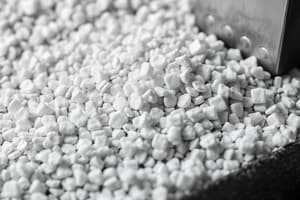Podcast
Questions and Answers
What is the force that causes a solid to be pushed together or forced to shorten in a specific direction?
What is the force that causes a solid to be pushed together or forced to shorten in a specific direction?
- Torsion
- Tensile
- Bending
- Compression (correct)
Which type of deformation causes the material to permanently change shape under compression forces?
Which type of deformation causes the material to permanently change shape under compression forces?
- Elastic region
- Rotational deformation
- Plastic deformation (correct)
- Elastic deformation
What is the force experienced by a solid when it is twisted or rotated about an axis?
What is the force experienced by a solid when it is twisted or rotated about an axis?
- Torsion (correct)
- Bending
- Compression
- Tensile
In the stress-strain curve for metals, what follows the initial elastic region?
In the stress-strain curve for metals, what follows the initial elastic region?
Which force causes a solid to maintain its width and length but decrease in height when compressed vertically?
Which force causes a solid to maintain its width and length but decrease in height when compressed vertically?
What kind of deformation can result from tensile forces?
What kind of deformation can result from tensile forces?
What type of force causes a solid to deform along a curved path?
What type of force causes a solid to deform along a curved path?
Which relationship is more complex under bending forces compared to other forces?
Which relationship is more complex under bending forces compared to other forces?
What factor does the behavior of the material under torsion depend on?
What factor does the behavior of the material under torsion depend on?
What are stress concentrations under bending forces?
What are stress concentrations under bending forces?
Study Notes
Forces Acting on Solids: Understanding Compression, Torsion, Tensile, and Bending
Solids, like materials in structures, machines, and everyday objects, are subject to various external forces that can cause deformation or failure. Understanding these forces, known as compression, torsion, tensile, and bending, is crucial for engineers and anyone interested in the behavior of solid materials.
Compression
Compression is the force that causes a solid to be pushed together or forced to shorten in a specific direction. For example, a cube compressed vertically will decrease in height while maintaining its width and length. This force can be applied through methods such as pressing two surfaces together or applying weights on top of the solid.
Compression forces can result in elastic deformation, going back to its original shape when the force is removed, or plastic deformation, which causes the material to permanently change shape. For metals, the stress-strain curve typically shows an initial elastic region, followed by a plastic region, and finally, a failure region.
Torsion
Torsion is the force experienced by a solid when it is twisted or rotated about an axis. The most common example of torsion is a solid rod twisted by applying forces at its ends. Torsion results in rotational deformation, and the material's response to this force can be described using the torque-angle relationship.
Torsion forces cause strain in the material, leading to a change in its shape and internal structure. The stress-strain relationship in torsion is more complex than in compression, and the behavior of the material depends on factors such as the material's properties, the geometry of the object, and the rate at which the torsion force is applied.
Tensile
Tensile force, also known as tensile stress, is the force applied along the length of a solid to cause it to elongate or stretch. For example, a rope with both ends pulled will experience tensile force. In materials science, tensile forces cause the material to be stretched in order to understand the material's elastic and plastic behavior.
Tensile forces can lead to elastic or plastic deformation, similar to compression forces. The stress-strain curve exhibits an initial elastic region, followed by a plastic region, and finally, a failure region. Understanding this relationship is essential for designing structures and materials that can withstand tensile forces.
Bending
Bending is the force that causes a solid to deform along a curved path. A common example is a beam subjected to a lateral force, causing it to bend at the point of contact. Bending forces can result in both elastic and plastic deformation, and the behavior of the material under bending depends on its properties, the geometry of the object, and the rate at which the bending force is applied.
The stress-strain relationship under bending forces is more complex than in the other forces, and it can be described using the moment-curvature relationship. Bending forces can lead to the development of stress concentrations, which are regions of high stress, and these concentrations can result in material failure if they are not managed properly.
In conclusion, understanding the forces acting on solids, such as compression, torsion, tensile, and bending, is crucial for engineers and anyone interested in the behavior of solid materials. By understanding the stress-strain relationships and the behavior of materials under these forces, it is possible to design and manufacture structures and components that can withstand the forces required of them.
Studying That Suits You
Use AI to generate personalized quizzes and flashcards to suit your learning preferences.
Description
Learn about the forces that act on solid materials, including compression, torsion, tensile, and bending. Explore how these forces cause deformation and understand the stress-strain relationships crucial for designing structures and materials.



